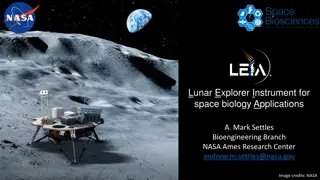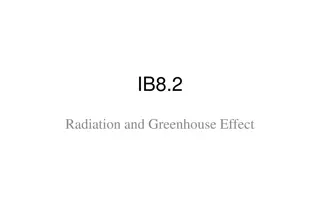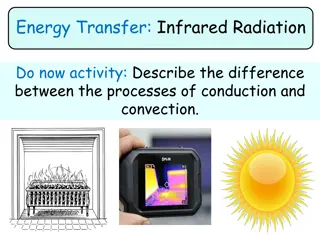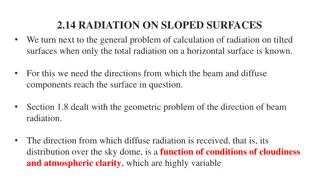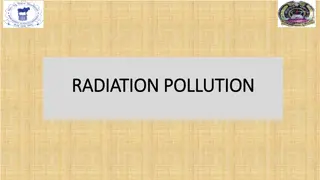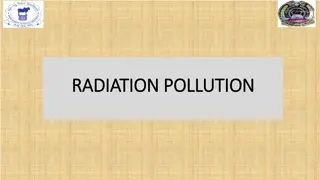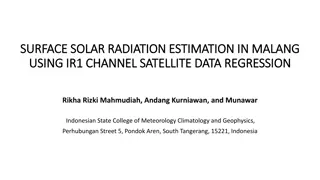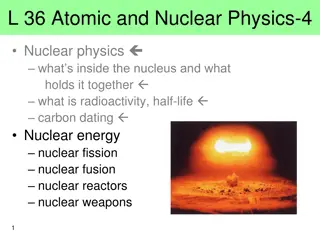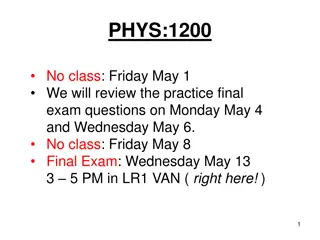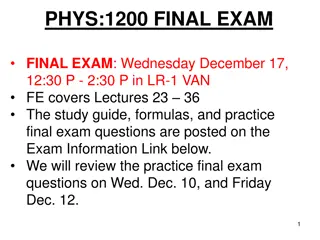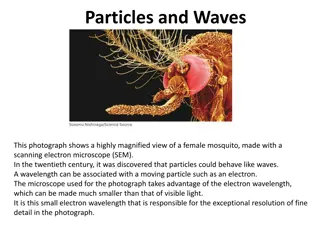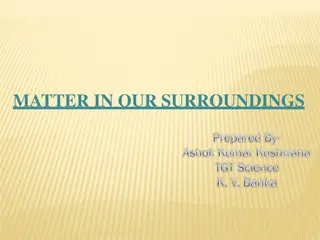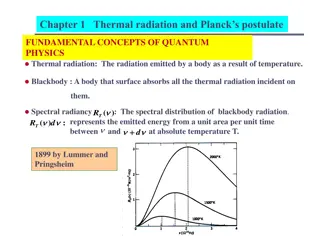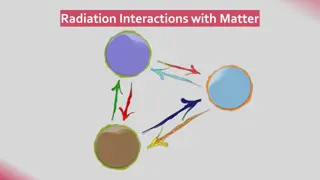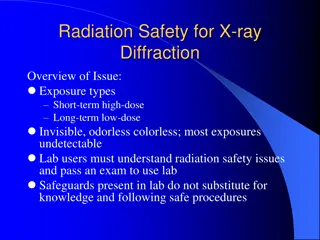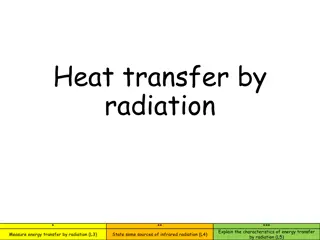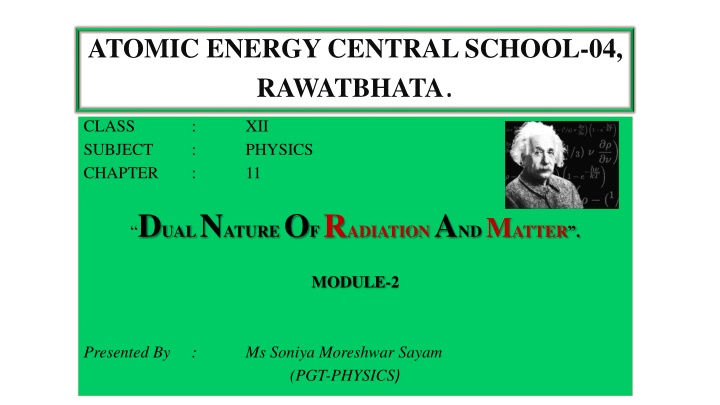
Photoelectric Effect in Physics Class XII
Explore the dual nature of radiation and matter in Physics Class XII, covering topics such as the effect of frequency, laws of photoelectric effect, failure of classical wave theory, and Einstein's photoelectric equation. Discover the impact of incident light intensity, threshold frequency, and the relationship between frequency and stopping potential. Gain insights into the laws governing photoelectric emission and the limitations of classical wave theory in explaining observable phenomena.
Download Presentation

Please find below an Image/Link to download the presentation.
The content on the website is provided AS IS for your information and personal use only. It may not be sold, licensed, or shared on other websites without obtaining consent from the author. If you encounter any issues during the download, it is possible that the publisher has removed the file from their server.
You are allowed to download the files provided on this website for personal or commercial use, subject to the condition that they are used lawfully. All files are the property of their respective owners.
The content on the website is provided AS IS for your information and personal use only. It may not be sold, licensed, or shared on other websites without obtaining consent from the author.
E N D
Presentation Transcript
ATOMIC ENERGY CENTRAL SCHOOL-04, RAWATBHATA. CLASS SUBJECT CHAPTER : : : XII PHYSICS 11 DUAL NATURE OF RADIATIONAND MATTER . MODULE-2 Presented By : Ms Soniya Moreshwar Sayam (PGT-PHYSICS)
Topics to be discussed o Effect of frequency o Laws of photoelectric effect o Failure of Classical Wave Theory o Einstein's photoelectric equation o Verification of laws of photoelectric emission based on Einstein's photoelectric equation
EFFECT OF FREQUENCY For a fixed intensity of incident light, the photo electric current does not depend on the frequency of the incident light. Saturation current will be same for all frequencies > Threshold frequency.
EFFECT OF FREQUENCY The graph between frequency and stopping potential is always a straight line and implies that there is always a minimum frequency below which there is no photocurrent. i. Slope of the graph corresponds to h/e which is a constant and independent of the material. ii. Intercept of this graph indicates threshold frequencies ?0 materials. It depends on the nature of the material. and ?0 of the given
LAWS OF PHOTOELECTRIC EFFECT 1. For a given metal and frequency of incident light, the photo electric current (the rate of emission of photoelectrons) is directly proportional to the intensity of incident light. 2. For a given metal, there is a certain minimum frequency, called threshold frequency, below which there is no emission of photo electrons takes place. 3. Above threshold frequency the maximum kinetic energy of photo electrons depends upon the frequency of incident light. 4. The photoelectric emission is an instantaneous process. i.e. as soon as the photon of suitable frequency falls on the substance, it emits photoelectrons.
ACCORDING TO CLASSICAL WAVE THEORY: Intensity of a wave is the energy incident per unit area per unit time. Energy carried by an electromagnetic wave is proportional to the square of the amplitude of the wave.
FAILLURE OF CLASSICAL WAVE THEORY: Classical wave theory cannot explain the first 3 observations of photoelectric effect 1. Existence of the threshold frequency Since energy of the wave is dependent on the square of its amplitude, the classical wave theory predicts that if sufficiently intense light is used, the electrons would absorb enough energy to escape. There should not be any threshold frequency. 2. Almost immediate emission of photoelectrons Based on classical wave theory, electrons require a period of time before sufficient energy is absorbed for it to escape from the metal. Accordingly, a dim light after some delay would transfer sufficient energy to the electrons for ejection, whereas a very bright light would eject electrons after a short while. However, this did not happen in photoelectric effect.
FAILLURE OF CLASSICAL WAVE THEORY: 3. The independence of kinetic energy of photoelectron on intensity and the dependence on frequency According to classical wave theory, if light of higher intensity is used, the kinetic energy of an ejected electron can be increased. This is because the greater the intensity, the larger the energy of the light wave striking the metal surface, so electrons are ejected with greater kinetic energy. However, it cannot explain why maximum kinetic energy is dependent on the frequency and independent of intensity.
EINSTEIN'S PHOTOELECTRIC EQUATION According to Plank's quantum theory, light is emitted from a source in the forms of bundles of energy called photons. Energy of each photon is ? = ? ?. Einstein made use of this theory to explain how photo electric emission takes place. According to Einstein, when photons of energy fall on a metal surface, they transfer their energy to the electrons of metal. i) A part of this energy is used to overcome the surface barrier and come out of the metal surface. This part of the energy is called work function ( ? = ???). ii)The remaining part of the energy is used in giving a velocity ? to the emitted photoelectron. This is equal to the maximum kinetic energy of the photoelectrons ???max ? ? where ? is mass of the photoelectron.
EINSTEIN'S PHOTOELECTRIC EQUATION According to law of conservation of energy, Energy of photon = Work function + K.E. imparted to electron 1 2??max 1 2??max 2 ? = 0 + ? = ??+ ????? = ????? = This relation is called Einstein s photoelectric equation. 2 ? ?? (? ?0 )
VERIFICATION OF LAWS OF PHOTOELECTRIC EMISSION BASED ON EINSTEIN S PHOTOELECTRIC EQUATION: If ? < ?? , then? is negative, which is not possible. Therefore, for photoelectric emission to take place > ?? ii) Since one photon emits one electron, so the number of photoelectrons emitted per second is directly proportional to the intensity of incident light. ? i) ???max ? ???max ? iii) It is clear that This shows that K.E. of the photoelectrons is directly proportional to the frequency of the incident light. iv) Photoelectric emission is due to collision between a photon and an electron. As such there can not be any significant time lag between the incidence of photon and emission of photoelectron. i.e. the process is instantaneous. It is found that delay is only 10 8seconds. is proportional to as h and ?? are constant.
THANK YOU FOR WATCHING! TO BE CONTINUED

